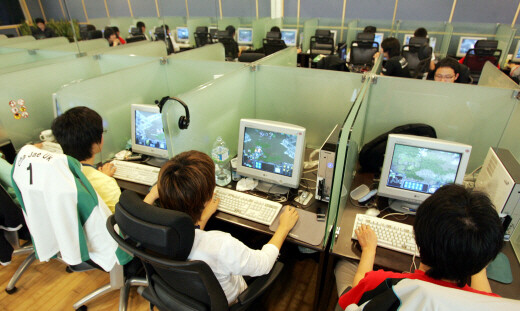hankyoreh
Links to other country sites 다른 나라 사이트 링크
Labor rights remain nonexistent for pro gamers

As recently as 1999, when Kim Dong-su, now 29, began playing the internationally popular StarCraft game in PC rooms, the term “pro gamer” was not well known. He enjoyed the game but did not know it was possible to make a living from it. The world has changed faster than expected, however, and Kim now works as a pro gamer and commentator.
Over the past decade or so, nationwide competitions like the KPGL (Korea Pro Game League) and Battletop have appeared, while viewership for game channels has increased. E-Sports developed rapidly with the participation of large Korean companies. In 2002, player Lim Yo-han earned an annual salary of 100 million Won ($84 thousand) and the attention of the media, one of a number of first-generation top StarCraft players who emerged during that time.
What has not yet received attention, however, is the dark side of anxiety and adverse working conditions facing many players amid this rapid growth in e-Sports. During a policy talk Thursday entitled “The Current Situation and Problems in the Gaming Industry and Game Sports,” organized by the Center for Culture & Society and the minor opposition New Progressive Party, StarCraft columnist Kim Jeong-geon made reference to a professional gamer development system he called “the chicken coop.”
The pro gamer development process described by Kim differs little from that seen with entertainers. Prospective gamers take tests based on the skills they have picked up in PC rooms, and passing scores allow them entree into “clans,” or guilds. Those who aspire to become pro gamers pay move-in fees and go to live at group dormitories, where they practice playing games all day long. Following a “courage match” for semi-pro certification, the hopefuls must take a test to become apprentices in a pro-gaming group.
Even after going through this entire process and becoming a Group 2 apprentice, the aspiring gamers do not yet receive anything worthy of being called wages. Around 5,000 people have entered courage matches to date, but the average number of people per year who are drafted into a team and become formal Group 2 members is 75. Of these, only an outstanding few become Group 1 members receiving annual salaries in the tens of millions of Won. Among those classified as semi-pro or higher, an average of 43.5 per year retire from the gaming world.
At present, there is no pro gamer association, and those not affiliated with a gaming group have their credentials suspended and are not allowed to compete.
“The standard in pro gaming groups is for people to live together 24 hours a day, 365 days a year, with no traveling to or from work, and for those ranked Group 2 or lower, their entire daily routine consists of eating, cleaning, laundry and games,” said Kim Jeong-geun. “Because of this structure of bringing in young people, developing them and then replacing them when their lifespan is spent and they have been squeezed dry, it has earned the name of ‘the chicken coop.’”
“Everyone knows about these problems, but if you start talking about players’ rights, everyone wants to keep quiet about it, scared they might be branded as an impediment to the growth of e-Sports,” said Kim Dong-su. “They need to introduce things like a minimum age system for players and limitations on the number of games.” Citing the example of fixed StarCraft matches uncovered on May 16 through an investigation by prosecutors, Kim said, “Because players have short lifespans and uncertain futures, you inevitably have a widespread sense of ‘Let’s pull something off while things are going well.’”
Please direct questions or comments to [englishhani@hani.co.kr]
Editorial・opinion
![[Guest essay] Maybe Korea’s rapid population decline is an opportunity, not a crisis [Guest essay] Maybe Korea’s rapid population decline is an opportunity, not a crisis](https://flexible.img.hani.co.kr/flexible/normal/500/300/imgdb/original/2024/0430/9417144634983596.jpg) [Guest essay] Maybe Korea’s rapid population decline is an opportunity, not a crisis
[Guest essay] Maybe Korea’s rapid population decline is an opportunity, not a crisis![[Column] Can Yoon steer diplomacy with Russia, China back on track? [Column] Can Yoon steer diplomacy with Russia, China back on track?](https://flexible.img.hani.co.kr/flexible/normal/500/300/imgdb/original/2024/0430/1617144616798244.jpg) [Column] Can Yoon steer diplomacy with Russia, China back on track?
[Column] Can Yoon steer diplomacy with Russia, China back on track?- [Column] Season 2 of special prosecutor probe may be coming to Korea soon
- [Column] Park Geun-hye déjà vu in Yoon Suk-yeol
- [Editorial] New weight of N. Korea’s nuclear threats makes dialogue all the more urgent
- [Guest essay] The real reason Korea’s new right wants to dub Rhee a founding father
- [Column] ‘Choson’: Is it time we start referring to N. Korea in its own terms?
- [Editorial] Japan’s rewriting of history with Korea has gone too far
- [Column] The president’s questionable capacity for dialogue
- [Column] Are chaebol firms just pizza pies for families to divvy up as they please?
Most viewed articles
- 1First meeting between Yoon, Lee in 2 years ends without compromise or agreement
- 2Under conservative chief, Korea’s TRC brands teenage wartime massacre victims as traitors
- 3Months and months of overdue wages are pushing migrant workers in Korea into debt
- 4[Guest essay] Maybe Korea’s rapid population decline is an opportunity, not a crisis
- 5[Column] Can Yoon steer diplomacy with Russia, China back on track?
- 6‘We must say no’: Seoul defense chief on Korean, USFK involvement in hypothetical Taiwan crisis
- 7Dermatology, plastic surgery drove record medical tourism to Korea in 2023
- 8After election rout, Yoon’s left with 3 choices for dealing with the opposition
- 9Two factors that’ll decide if Korea’s economy keeps on its upward trend
- 10[Column] Behind factional animus of Korean politics, victim mentality festers